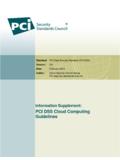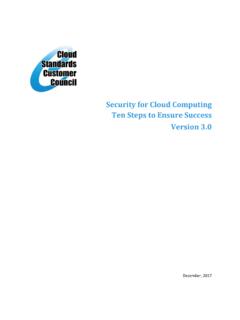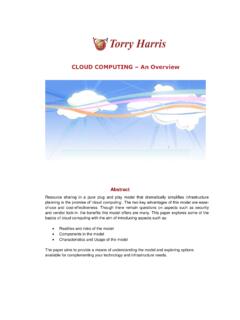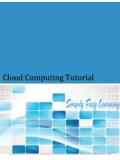Transcription of Cloud Computing Tutorial - RxJS, ggplot2, Python Data ...
1 Cloud Computing Tutorial Cloud COMPUTINGTUTORIAL. Simply Easy Learning by i ABOUT THE Tutorial . Cloud Computing Tutorial Cloud Computing provides us a means by which we can access the applications as utilities, over the internet. It allows us to create, configure, and customize the business applications online. This Tutorial will take you through a step-by-step approach while learning Cloud Computing concepts. Audience This reference has been prepared for the beginners to help them to understand the basic-to-advanced concepts related to Cloud Computing . This Tutorial will give you enough understanding on Cloud Computing concepts from where you can take yourself to a higher level of expertise. Prerequisites Before proceeding with this Tutorial , you should have basic knowledge of Computers, Internet, Database and Networking concepts. Such basic knowledge will help you in understanding the Cloud Computing concepts and move fast on the learning track.
2 Copyright & Disclaimer Notice All the content and graphics on this Tutorial are the property of Any content from or this Tutorial may not be redistributed or reproduced in any way, shape, or form without the written permission of Failure to do so is a violation of copyright laws. This Tutorial may contain inaccuracies or errors and tutorialspoint provides no guarantee regarding the accuracy of the site or its contents including this Tutorial . If you discover that the site or this Tutorial content contains some errors, please contact us at TUTORIALS POINT. Simply Easy Learning Table of Content Cloud Computing 2. Audience .. 2. Prerequisites .. 2. Copyright & Disclaimer Notice .. 2. Cloud Computing - Overview .. 9. What is Cloud ? .. 9. What is Cloud Computing ? .. 9. Basic 10. DEPLOYMENT MODELS .. 10. History .. 12. Benefits .. 12. Risks .. 13.
3 SECURITY & PRIVACY .. 13. LOCK-IN .. 13. ISOLATION FAILURE .. 13. MANAGEMENT INTERFACE COMPROMISE .. 14. INSECURE OR INCOMPLETE data DELETION .. 14. Characteristics .. 14. ON DEMAND SELF-SERVICE .. 14. BROAD NETWORK ACCESS .. 14. RESOURCE POOLING .. 15. RAPID ELASTICITY .. 15. MEASURED SERVICE .. 15. Cloud Computing - Planning .. 16. Strategy Planning Phase .. 17. Cloud Computing VALUE PROPOSITION .. 17. Cloud Computing STRATEGY PLANNING .. 18. Cloud Computing Tactics Planning Phase .. 18. BUSINESS ARCHITECTURE DEVELOPMENT .. 18. IT ARCHITECTURE DEVELOPMENT .. 18. REQUIREMENTS ON QUALITY OF SERVICE DEVELOPMENT .. 18. TRANSFORMATION PLAN DEVELOPMENT .. 18. Cloud Computing Deployment Phase .. 18. Cloud Computing PROVIDER .. 19. MAINTENANCE AND TECHNICAL SERVICE .. 19. Cloud Computing -Technologies .. 20. Virtualization .. 20. TUTORIALS POINT.
4 Simply Easy Learning Service-Oriented Architecture(SOA).. 21. Grid Computing .. 22. Utility Computing .. 23. Cloud Computing -Architecture .. 24. FRONT END .. 25. BACK END .. 25. Cloud Computing 26. HYPERVISOR .. 26. MANAGEMENT SOFTWARE .. 26. DEPLOYMENT SOFTWARE .. 26. NETWORK .. 26. SERVER .. 27. STORAGE .. 27. Infrastructural Constraints .. 27. TRANSPARENCY .. 27. SCALABILITY .. 27. INTELLIGENT MONITORING .. 27. SECURITY .. 28. Public Cloud Model .. 29. Benefits .. 30. COST EFFECTIVE .. 30. 30. FLEXIBILITY .. 30. LOCATION INDEPENDENCE .. 30. UTILITY STYLE COSTING .. 30. HIGH SCALABILITY .. 30. Disadvantages .. 31. LOW 31. LESS CUSTOMIZABLE .. 31. Private Cloud Model .. 32. HIGHER SECURITY AND PRIVACY .. 33. MORE 33. COST AND ENERGY EFFICIENCY .. 33. Disadvantages .. 33. RESTRICTED AREA .. 33. INFLEXIBLE 33. LIMITED SCALABILITY .. 33. ADDITIONAL SKILLS.
5 34. Hybrid Cloud 35. TUTORIALS POINT. Simply Easy Learning Benefits .. 35. SCALABILITY .. 36. FLEXIBILITY .. 36. COST EFFICIENCIES .. 36. SECURITY .. 36. Disadvantages .. 36. NETWORKING ISSUES .. 36. SECURITY COMPLIANCE .. 36. INFRASTRUCTURAL DEPENDENCY .. 37. Community Cloud Model .. 38. Benefits .. 39. COST EFFECTIVE .. 39. SECURITY .. 39. ISSUES .. 39. 40. Benefits .. 41. FULL CONTROL OVER Computing RESOURCES THROUGH. ADMINISTRATIVE ACCESS TO VMS .. 41. FLEXIBLE AND EFFICIENT RENTING OF COMPUTER HARDWARE . 42. PORTABILITY, INTEROPERABILITY WITH LEGACY APPLICATIONS 42. Issues .. 42. COMPATIBILITY WITH LEGACY SECURITY VULNERABILITIES .. 42. VIRTUAL MACHINE SPRAWL .. 43. ROBUSTNESS OF VM-LEVEL ISOLATION .. 43. data ERASE PRACTICES .. 43. Characteristics .. 43. Platform-as-a-Service .. 44. Benefits .. 45. LOWER ADMINISTRATIVE OVERHEAD .. 46.
6 LOWER TOTAL COST OF OWNERSHIP .. 46. SCALABLE SOLUTIONS .. 46. MORE CURRENT SYSTEM SOFTWARE .. 46. Issues .. 46. LACK OF PORTABILITY BETWEEN PAAS CLOUDS .. 47. EVENT BASED PROCESSOR SCHEDULING .. 47. SECURITY ENGINEERING OF PAAS APPLICATIONS .. 47. Characteristics .. 47. PaaS Types .. 48. STAND-ALONE DEVELOPMENT ENVIRONMENTS .. 48. TUTORIALS POINT. Simply Easy Learning APPLICATION DELIVERY-ONLY ENVIRONMENTS .. 48. OPEN PLATFORM AS A SERVICE .. 48. ADD-ON DEVELOPMENT FACILITIES .. 48. Software-as-a-Service .. 49. Characteristics .. 49. Benefits .. 50. MODEST SOFTWARE TOOLS .. 50. EFFICIENT USE OF SOFTWARE 50. CENTRALIZED MANAGEMENT & data .. 50. PLATFORM RESPONSIBILITIES MANAGED BY PROVIDERS .. 50. MULTITENANT SOLUTIONS .. 50. Issues .. 51. BROWSER BASED RISKS .. 51. NETWORK DEPENDENCE .. 51. LACK OF PORTABILITY BETWEEN SAAS CLOUDS .. 51. OPEN SAAS AND SOA.
7 51. ldentity-as-a-Service .. 53. Identity .. 53. Single Sign-On (SSO) .. 54. SSO WORKING .. 54. Federated Identity Management (FIDM) .. 55. OpenID .. 56. Benefits .. 56. Network-as-a-Service .. 57. How NaaS is delivered? .. 57. Mobile NaaS .. 57. NaaS 58. INDEPENDENCE .. 59. BURSTING .. 59. RESILIENCE .. 59. ANALYTICS .. 59. EASE OF ADDING NEW SERVICE ELEMENTS .. 59. SUPPORT MODELS .. 60. ISOLATION OF CUSTOMER TRAFFIC .. 60. Cloud Computing Management .. 61. Cloud Management Tasks .. 61. AUDIT SYSTEM BACKUPS .. 62. SYSTEM'S data FLOW .. 62. BEWARE OF VENDOR LOCK-IN .. 62. TUTORIALS POINT. Simply Easy Learning KNOWING PROVIDER'S SECURITY 62. MONITOR CAPACITY PLANNING AND SCALING CAPABILITIES .. 62. MONITOR AUDIT-LOG USE .. 62. SOLUTION TESTING AND VALIDATION .. 62. Cloud Computing data 63. Storage Devices .. 63. BLOCK STORAGE DEVICES .. 63.
8 FILE STORAGE DEVICES .. 63. Cloud Storage Classes .. 63. UNMANAGED Cloud STORAGE .. 63. MANAGED Cloud STORAGE .. 64. Creating Cloud Storage System .. 64. Virtual Storage Containers .. 64. 65. Cloud Computing Virtualization .. 66. Virtualization Concept .. 66. HYPERVISOR .. 66. Types of Hardware Virtualization .. 68. FULL VIRTUALIZATION .. 68. EMULATION VIRTUALIZATION .. 69. PARAVIRTUALIZATION .. 70. Cloud Computing 72. Security 72. Understanding Security of Cloud .. 72. SECURITY BOUNDARIES .. 72. UNDERSTANDING data 73. ISOLATED ACCESS TO data .. 74. WORKING OF BROKERED Cloud STORAGE ACCESS SYSTEM .. 74. 75. Cloud Computing Operations .. 76. Managing Cloud Operations .. 76. Cloud Computing Applications .. 78. Business Applications .. 78. data Storage and Backup .. 78. Management Applications .. 79. Social Applications .. 79. Entertainment Applications.
9 79. Art 79. Cloud Computing Providers .. 80. TUTORIALS POINT. Simply Easy Learning Cloud Computing Challenges .. 82. SECURITY & 82. 82. 83. Computing PERFORMANCE .. 83. RELIABILITY AND AVAILABILITY .. 83. Mobile Cloud Computing .. 84. Architecture .. 84. Issues .. 85. EMERGENCY EFFICIENT 85. ARCHITECTURAL ISSUES .. 85. LIVE VM MIGRATION .. 85. MOBILE COMMUNICATION CONGESTION .. 85. SECURITY AND PRIVACY .. 86. TUTORIALS POINT. Simply Easy Learning 1. CHAPTER. Cloud Computing - Overview C loud Computing provides us a means by which we can access the applications as utilities, over the Internet. It allows us to create, configure, and customize applications online. What is Cloud ? The term Cloud refers to a Network or Internet. In other words, we can say that Cloud is something, which is present at remote location. Cloud can provide services over network, , on public networks or on private networks, , WAN, LAN or VPN.
10 Applications such as e-mail, web conferencing, customer relationship management (CRM),all run in Cloud . What is Cloud Computing ? Cloud Computing refers to manipulating, configuring, and accessing the applications online. It offers online data storage, infrastructure and application. TUTORIALS POINT. Simply Easy Learning We need not to install a piece of software on our local PC and this is how the Cloud Computing overcomes platform dependency issues. Hence, the Cloud Computing is making our business application mobile and collaborative. Basic Concepts There are certain services and models working behind the scene making the Cloud Computing feasible and accessible to end users. Following are the working models for Cloud Computing : Deployment Models Service Models DEPLOYMENT MODELS. Deployment models define the type of access to the Cloud , , how the Cloud is located?


















